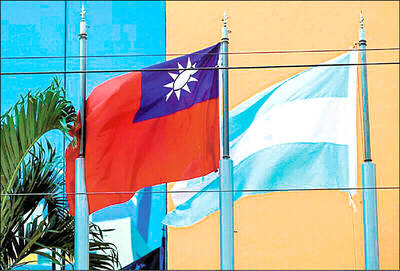A group of young people yesterday took the initiative to show their friendliness and appreciation for Filipino workers in Taiwan amid ongoing tensions between the two countries over the killing of a Taiwanese fisherman last week by Philippine Coast Guard (PCG) personnel.
Holding up Chinese and English signs that read “I’m Taiwanese supporting Filipino workers” and “The government’s wrongdoing should not be shouldered by innocent people,” the young people stood outside St Christopher’s Church in Taipei, which has a large Filipino congregation, early yesterday morning before the first Mass in Tagalog started at 7:30am.
“There’s no organization behind us, I invited my friends to join me in the action on Facebook and they forwarded the invitation to their friends,” said Lee Chun-ta (李俊達), a graduate student who initiated the event.

Photo: Chang Chia-ming, Taipei Times
He said that despite the difference in language and culture, Filipino workers are no different from Hung Shih-cheng (洪石成), the Taiwanese fisherman shot dead by the PCG personnel.
“They are all hardworking people trying to make a living,” he said.
Another female demonstrator, also surnamed Lee (李), said that Filipino workers and domestic caregivers make a big contribution to Taiwan.
“Filipino workers fill up the gap in our social welfare network. They take care of our elderly and children so that people can work without worrying. They also work on assembly lines or in construction site jobs that many Taiwanese workers don’t want to do,” she said.
“Filipino workers should not shoulder responsibility for their government’s wrongdoing. It’s just like we Taiwanese wouldn’t want to be held responsible for what President Ma Ying-jeou (馬英九) does,” Lee said.
Many Filipino workers as well as a Filipino priest stopped to express their gratitude for the support and took pictures with the students.
“I work as a domestic caregiver and my boss and his family treats me very well, so I don’t feel threatened at work,” Filipino worker Ana Baltazar said. “But I am really worried that the Taiwanese government’s policies may affect my job.”
Baltazar said she has only been working in Taiwan for five months and is worried that she may not be able to come back after her three-year contract ends.
“I came to Taiwan to work because I have no job in the Philippines, but I have two children to raise and I am separated from my husband,” Baltazar said. “I make NT$15,840 a month, but after deduction of broker and government fees, I only get a little over NT$12,000. Half of that money is wired to my family and the other half goes to repay the loan that I took out to come to Taiwan.”
Santiago Salud, a Filipino who has married a Taiwanese, said he understands the suffering of the fisherman’s family, but urged the public not to blame Filipinos in Taiwan.
“I know how the family feels because I used to be a fisherman as well and I’ve worked on a Taiwanese fishing vessel. I know how hard it is at sea,” he said.
While the Philippine government said Hung’s vessel had crossed into Philippine waters, Salud said he did not know exactly what happened, but based on his own experiences, it is not always easy to tell where a boundary is since they are not marked on the sea.
However, whatever may have happened, he said there was no justification for shooting dead an unarmed fisherman.
“But it’s the shooter that should held responsible, not all Filipinos,” Salud said.
Later in the afternoon in front of the church, Filipino workers said prayers for Hung and for friendly relations between Taiwan and the Philippines.

Chinese Nationalist Party (KMT) Chairman Eric Chu (朱立倫), spokeswoman Yang Chih-yu (楊智伃) and Legislator Hsieh Lung-chieh (謝龍介) would be summoned by police for questioning for leading an illegal assembly on Thursday evening last week, Minister of the Interior Liu Shyh-fang (劉世芳) said today. The three KMT officials led an assembly outside the Taipei City Prosecutors’ Office, a restricted area where public assembly is not allowed, protesting the questioning of several KMT staff and searches of KMT headquarters and offices in a recall petition forgery case. Chu, Yang and Hsieh are all suspected of contravening the Assembly and Parade Act (集會遊行法) by holding

PRAISE: Japanese visitor Takashi Kubota said the Taiwanese temple architecture images showcased in the AI Art Gallery were the most impressive displays he saw Taiwan does not have an official pavilion at the World Expo in Osaka, Japan, because of its diplomatic predicament, but the government-backed Tech World pavilion is drawing interest with its unique recreations of works by Taiwanese artists. The pavilion features an artificial intelligence (AI)-based art gallery showcasing works of famous Taiwanese artists from the Japanese colonial period using innovative technologies. Among its main simulated displays are Eastern gouache paintings by Chen Chin (陳進), Lin Yu-shan (林玉山) and Kuo Hsueh-hu (郭雪湖), who were the three young Taiwanese painters selected for the East Asian Painting exhibition in 1927. Gouache is a water-based

Taiwan would welcome the return of Honduras as a diplomatic ally if its next president decides to make such a move, Minister of Foreign Affairs Lin Chia-lung (林佳龍) said yesterday. “Of course, we would welcome Honduras if they want to restore diplomatic ties with Taiwan after their elections,” Lin said at a meeting of the legislature’s Foreign Affairs and National Defense Committee, when asked to comment on statements made by two of the three Honduran presidential candidates during the presidential campaign in the Central American country. Taiwan is paying close attention to the region as a whole in the wake of a

OFF-TARGET: More than 30,000 participants were expected to take part in the Games next month, but only 6,550 foreign and 19,400 Taiwanese athletes have registered Taipei city councilors yesterday blasted the organizers of next month’s World Masters Games over sudden timetable and venue changes, which they said have caused thousands of participants to back out of the international sporting event, among other organizational issues. They also cited visa delays and political interference by China as reasons many foreign athletes are requesting refunds for the event, to be held from May 17 to 30. Jointly organized by the Taipei and New Taipei City governments, the games have been rocked by numerous controversies since preparations began in 2020. Taipei City Councilor Lin Yen-feng (林延鳳) said yesterday that new measures by